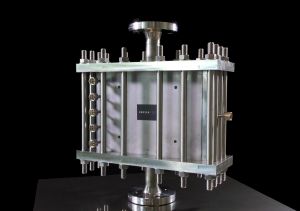The production plant made up of container-sized units assembled on the LUT campus will be completed in 2017. The purpose of this cooperative project is to convert solar power-produced electricity into gas or liquid fuels.
Production of synthetic fuels from solar energy and carbon dioxide extracted from air is the objective of the SOLETAIR project started now by INERATEC, a spinoff of Karlsruhe Institute of Technology (KIT), in cooperation with the Finnish partners. The three partners plan to build the world’s first operational compact chemical plant.. The pilot plant is so compact that it fits into a ship container and produces gasoline, diesel, and kerosene from regenerative hydrogen and carbon dioxide.
Photo: INERATEC/KIT
“We are proud of our participation in this promising international project,” INERATEC founder Dr. Tim Böltken emphasizes. In the future, KIT, INERATEC, and VTT plan to extend their cooperation. Under the national research alliances of “Energy Lab 2.0” and “Neo-Carbon Energy,” work will focus on the investigation and development of innovative energy systems based on renewable energy sources, novel storage technologies, and the conversion of renewable energies into chemical energy carriers. In addition, KIT and INERATEC contribute their expertise to the “Power-to-X” Kopernikus project funded by the Federal Ministry of Education and Research.
“The energy project will only be a success, if we pool our know-how and jointly strengthen the competencies of European industry in the energy sector,” VTT scientist and SOLETAIR project head Dr. Pekka Simell says with respect to the planned cooperation. The new power-to-liquid plant will be taken into operation at the BIORUUKKI Piloting Center of VTT this year. In 2017, operation is planned to be continued on the campus of LUT. The SOLETAIR project will be completed in mid-2018. It is funded with EUR 1 million by the Finnish Funding Agency for Technology and Innovation (Tekes).
The plant will be used to demonstrate how processes can be combined in a way that allows the use of renewable electricity in the production of methane, fuels and chemicals. The demo plant could also function as a fueling station for vehicles that run on hydrogen or natural gas.
“This research is the first of its kind in Finland in this type of combination of processes,” states LUT Professor Jero Ahola, who is responsible for the research.
“The project will produce expertise for enterprises in various fields, and it will result in a multidisciplinary industrial integration that no one company can achieve on its own. Collaboration will strengthen the expertise of Finnish industry in this sector,” states VTT’s Principal Scientist Pekka Simell. He is responsible for coordinating the project as well as VTT’s share of the research.
To help cut carbon dioxide emissions, in the future, all sectors of industry must be within the scope of carbon dioxide emission-free energy production. In practice, this means that the future’s most important energy market will be the electricity market, where different sectors of industry will operate with electricity produced from carbon dioxide emission-free energy sources. Combining the electricity system and other energy systems will be successful with the researched methods.



